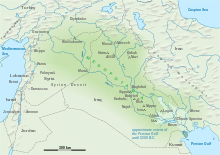Washukanni
Washukanni (also spelled Waššukanni) was the capital of the Hurrian kingdom of Mitanni, from around 1500 BC to the 13th century BC. Its precise location is unknown.[1] A proposal by Dietrich Opitz located it under the largely unexcavated mound of Tell el Fakhariya, near Tell Halaf in Syria.[2] A neutron activation comparison with clay from relevant Amarna tablets appeared to rule out Tell Fakhariya.[3] This idea was also rejected by Edward Lipinski.[4] However, this identification received a new support by Stefano de Martino, Mirko Novák and Dominik Bonatz due to recent archaeological excavations by a German team.[5]
The city is known to have been sacked by the Hittites under Suppiluliuma I (reigned c. 1344–1322 BC) in the first years of his reign, whose treaty inscription[6] relates that he installed a Hurrian vassal king, Shattiwaza. The city was sacked again by the Assyrian king Adad-nirari I around 1290 BC, but very little else is known of its history.
See also[]
- Mitanni
- Cities of the ancient Near East
References[]
- ^ Parrot André. Barthel Hrouda, Waššukanni, Urkiš, Śubat-Enlil, dans MDOG, 90 (janvier 1958) In: Syria. Tome 37 fascicule 1-2, 1960. pp. 191-192
- ^ D. Opitz, "Die Lage von Wassugganni", ZA 37, pp. 299-301, 1927
- ^ [1]Allan Dobel, "NEUTRON ACTIVATION ANALYSIS AND THE LOCATION OF WASSUKANNI", Lawrence Berkeley National Laboratory, 1976-12-01
- ^ Lipiński, Edward (2000). The Aramaeans: Their Ancient History, Culture, Religion. Peeters Publishers. p. 120. ISBN 978-90-429-0859-8.
- ^ De Martino, Stefano, 2018. "Political and Cultural Relations between the Kingdom of Mittani and its Subordinated Polities in Syria and Southeast Anatolia", in Changing Faces of Kingship in Syria-Palestine 1500-500 BCE, Ugarit Verlag, p. 38: "...the recent German archaeological excavations at Tell Fekheriye support the assumption that the capital of Mittani, Wassukkanni, was located there..." See also Novák (2013: 346) and Bonatz (2014).
- ^ Suppiluliuma-Shattiwaza treaty excerpts. GeoCities, archived at webcitation.org and archive.org
- Hurrian cities
- Bronze Age sites in Syria
- Lost ancient cities and towns
